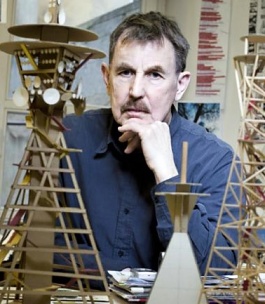
Vlado Milunič is trying to bring a bit of the Mediterranean even to Prague
Prague - To architect Vlado Milunič, the panel houses and other buildings with flat roofs appear as headless human figures. He himself, therefore, prefers steeples complemented by a rooftop landscape that reminds him of his native Mediterranean region. He has plenty of plans in his head and on paper, with the most developed ideas being light footbridges over the Jelení ditch or from Masaryk embankment to Žofín and Střelecký Island and further to Kampa. However, he believes that corruption is destroying Czech architecture. Today, few investors are brave enough to let such a prominent object enter Prague as was the Dancing House in the 1990s.
Vlado Milunič, who celebrated his 75th birthday on Thursday, worked on it with one of the most famous architects of our time, Frank Gehry. In an interview with ČTK, he reminisced about the history of its creation and his chance meeting with former president Václav Havel, who, along with the architect, stood behind the idea of filling the vacancy at the embankment.
As a family of six, the Miluničs couldn't fit into an apartment in a panel building in the 1980s and were assigned an apartment in the Havel family house on the embankment. "We ended up in an empty third floor, which was taken from them in 1948. We had no furniture, and the Havels asked us to take their original furniture. When their parents died, Václav asked me if I could make a division of the apartment for two families, for Ivan and for him," recalls the architect.
"And because Václav was in prison every other minute at the end of the 80s, I made a joke and separated the living room from the study with a grille and placed a modest prison bed behind it, so he wouldn't suffer shocks when he often alternated between home confinement and prison. He took it as a joke, and Olga and I then collaborated on further modifications of the apartment," he laughs, even while remembering the frequent interrogations by the State Security, which wanted to intervene in the reconstruction and place more and more wiretaps in the apartment.
The vacancy next to the house where the Havels lived had been there since the bombing in 1945. In the early 90s, Havel and Milunič came up again with the idea of filling it. "I wanted that building to be a paraphrase of the Velvet Revolution, on another level representing a totalitarian society from which a smaller part separated and ventured into a world of change," he says, looking at his original design of a dynamically appearing building seemingly connected from two parts. Originally, the building was supposed to have a predominantly cultural purpose, with shops or refreshments. However, no investor could be found, and moreover, as the architect states, "the conservationists were going crazy that I was destroying a globally unique row of buildings on the embankment."
However, it was significant that the Dancing House was liked by the managers of Nationale Nederlanden Real estate, who became the investor. "I told them that I would overcome the resistance by teaming up with a world star," Milunič says. Jean Nouvel, who later built the Golden Angel, did not work out, but Frank Gehry did, whom Milunič recommended to the managers. "He was a star before whom everyone bowed. He made these legs," he points to a model that, before Gehry's arrival, had entirely straight legs.
The first task for Milunič after the Dancing House was a residential area in Petřiny, where he tried to bring traditional urban order to the housing estate. "The French invented panel buildings. Their housing estates are in ugly locations, but in Prague, they have amazing locations," he says, mentioning Petřiny, where he dealt with panels set longitudinally and transversely, and a tall hotel in the open space. He complemented them with buildings that rise towards the tallest one, create inner blocks, are colorful, and have slanted roofs. "It's my Mediterranean theme; I hate flat roofs, they're like a severed head," the architect states.
A similar project in Malešice, however, did not work out for Milunič, even though he won both the architectural and business competitions. The project returned to the table by the developer who lost the competition but had and has strong connections with politicians. Milunič is still proud of his completed projects of social housing, which he worked on with architect Jan Línek.
He is working on several private houses, even participating in a project for the development of part of the port in the Croatian city of Rijeka, and has ideas on the table on how to relieve the overcrowded Charles Bridge at Prague Castle, for which he has proposed two lightweight footbridges over the Jelení ditch. He is also designing footbridges for access from the embankment to Prague's islands; he does not yet have an investor for them, but he believes that the city or the Administration of Prague Castle will appreciate them. He sees them as his contribution to improving the city where he lives.










